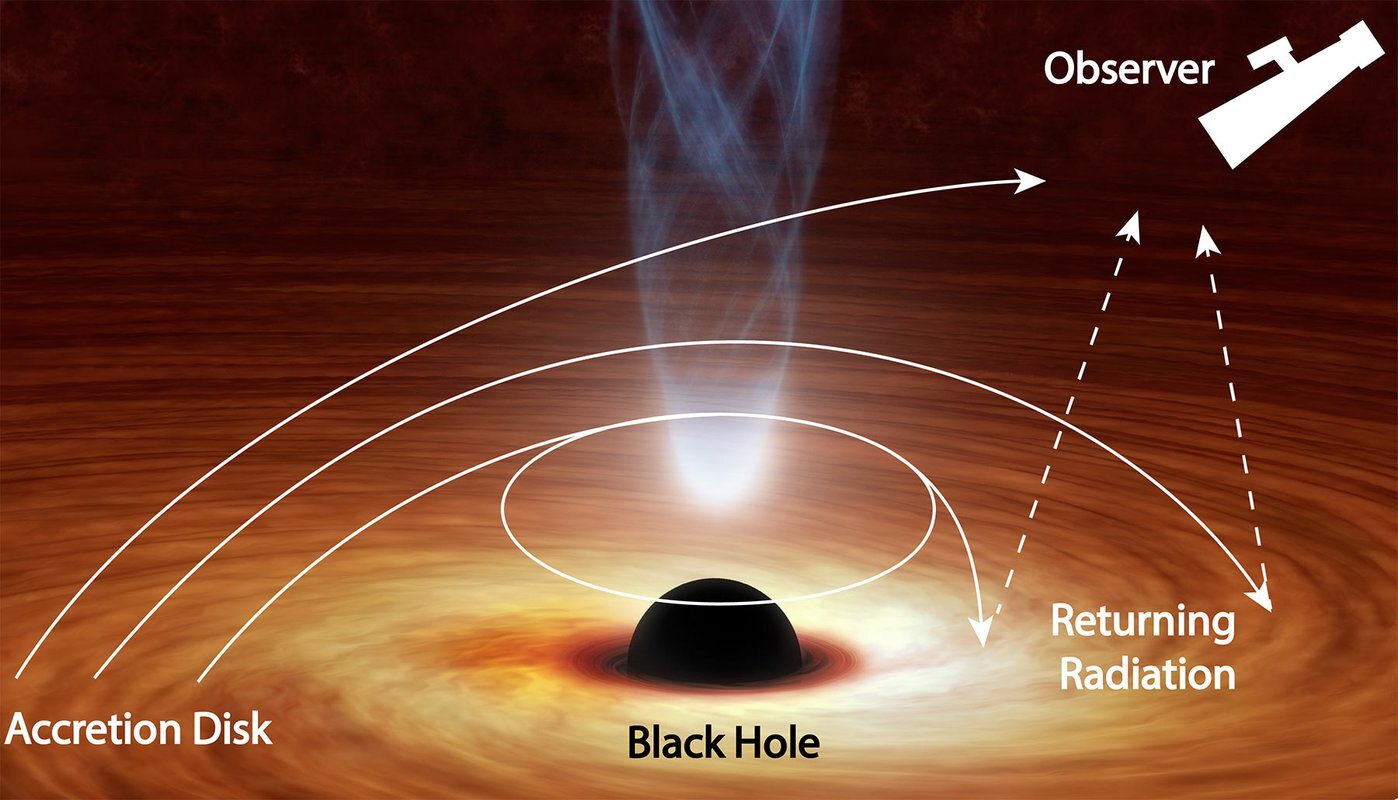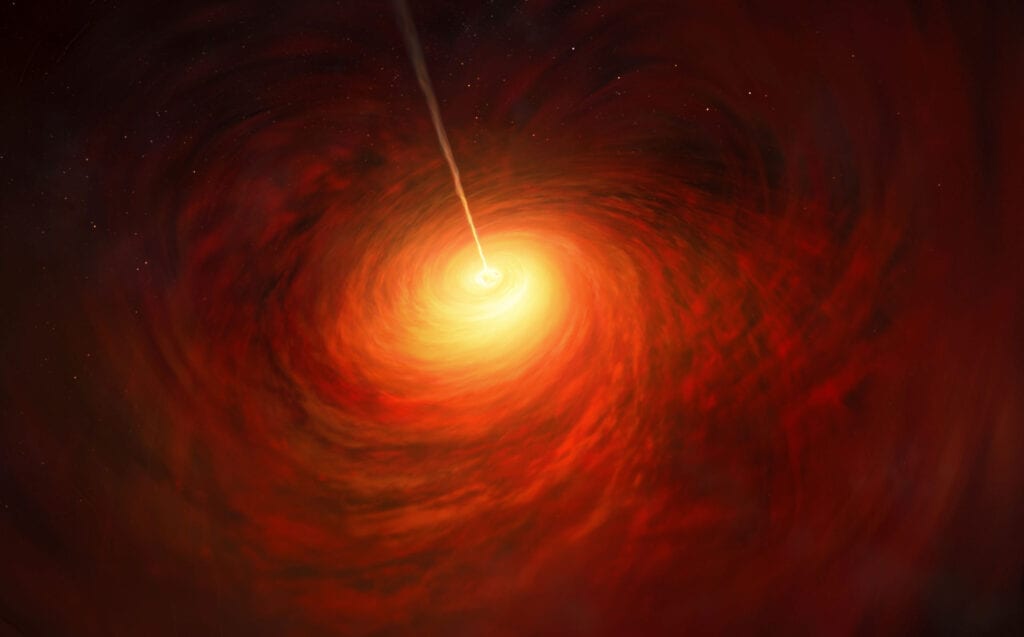Puzzling Corona Caused Black Hole Flare

A black hole may flare when its corona – a mysterious source of highly energetic particles – launches away from the hole at close to 20 percent of light speed.
Artist’s concept of a supermassive black hole, surrounded by a swirling disk of material falling onto it. The purplish ball of light depicted launching from the black hole is its corona. The launch of the corona may generate an X-ray flare.
When we speak of flares from black hole, people always say:
I thought nothing could escape a black hole …
And that is true. Black holes, by definition, have such powerful gravity that nothing, not even light, can escape them. But black holes also create interesting regions around themselves, just outside what astronomers call their event horizons, which is a black hole’s point of no return. Outside that boundary, flares can and do escape black holes, and astronomers in recent years have been determined to figure how why and how. This week – October 27, 2015 – NASA said that new observations from two missions – Swift and the Nuclear Spectroscopic Telescope Array, or NuSTAR – recently caught a supermassive black hole in the midst of a giant X-ray flare. These new observations are helping astronomers understand how supermassive black holes emit colossal flares.

The results point to supermassive black hole coronas – mysterious sources of highly energetic particles in the vicinity of the holes. They suggest that supermassive black holes send out beams of X-rays when the coronas shoot, or launch, away from the black holes at speeds close to 20 percent the speed of light.
If you haven’t been following supermassive black hole research very closely, then the word corona in this context might be new. We know that supermassive black holes are encircled by disks of hot, glowing material. The gravity of a black hole pulls swirling gas into it, heating this material and causing it to shine with different types of light. Over the past few decades, those various forms of emission are what we’ve come to associate with black holes.
In recent years, though, astronomers have come to visualize another source of radiation near a black hole disk. That is the mysterious corona. Astronomers visualize coronas as being made up of highly energetic particles that generate X-ray light. But details about coronas – how they form, what they look like, even where they are exactly it the region surrounding the hole – are unclear.
However, according to this new research, supermassive black hole coronas do seem to be the culprit in causing flares. The flares result not just from the coronas themselves, but their high-speed launch away from the hole. Dan Wilkins of Saint Mary’s University in Halifax, Canada is lead author of a new paper on these results. The paper appears in the Monthly Notices of the Royal Astronomical Society.
This is the first time we have been able to link the launching of the corona to a flare.
This will help us understand how supermassive black holes power some of the brightest objects in the universe.
Astronomers think coronas have one of two likely configurations.
The lamppost model says they are compact sources of light, similar to light bulbs, that sit above and below the black hole, along its rotation axis.
The sandwich model proposes that the coronas are spread out more diffusely, either as a larger cloud around the black hole, or as a sort of sandwich that envelops the surrounding disk of material like slices of bread.
In fact, according to the statement at JPL’s site, it’s possible that coronas switch between both the lamppost and sandwich configurations. However, the statement explained:
The new data support the lamppost model …
The observations began in 2007, when the Swift satellite, which monitors the sky for cosmic outbursts of X-rays and gamma rays, caught a large flare coming from the supermassive black hole called Markarian 335, or Mrk 335, located 324 million light-years away in the direction of the constellation Pegasus. This supermassive black hole, which sits at the center of a galaxy, was once one of the brightest X-ray sources in the sky. Luigi Gallo, the principal investigator for the project at Saint Mary’s University, said:
Something very strange happened in 2007, when Mrk 335 faded by a factor of 30. What we have found is that it continues to erupt in flares but has not reached the brightness levels and stability seen before.
Seven years later, in September 2014, Swift again caught Mrk 335 in a huge flare. Once Gallo found out, he sent a request to the NuSTAR team to quickly follow up.
Eight days later, NuSTAR set its X-ray eyes on the target, witnessing the final half of the flare event.
After careful scrutiny of the data, the astronomers said, they realized they were seeing the ejection, and eventual collapse, of the black hole’s corona. Dan Wilkins said:
The corona gathered inward at first and then launched upwards like a jet. We still don’t know how jets in black holes form, but it’s an exciting possibility that this black hole’s corona was beginning to form the base of a jet before it collapsed.
So the nature of black hole flares – and of the energetic source of X-rays called coronas in the vicinity of black holes – remains mysterious. But astronomers are now getting clues about the corona’s size and structure.
As to what causes the ejection of the corona in the first place … that puzzle remains unsolved and entirely mysterious.
Bottom line: Supermassive black hole coronas are mysterious sources of highly energetic particles in the holes’ vicinity. A black hole may flare when its corona launches away from the hole at speeds close to 20 percent the speed of light.




